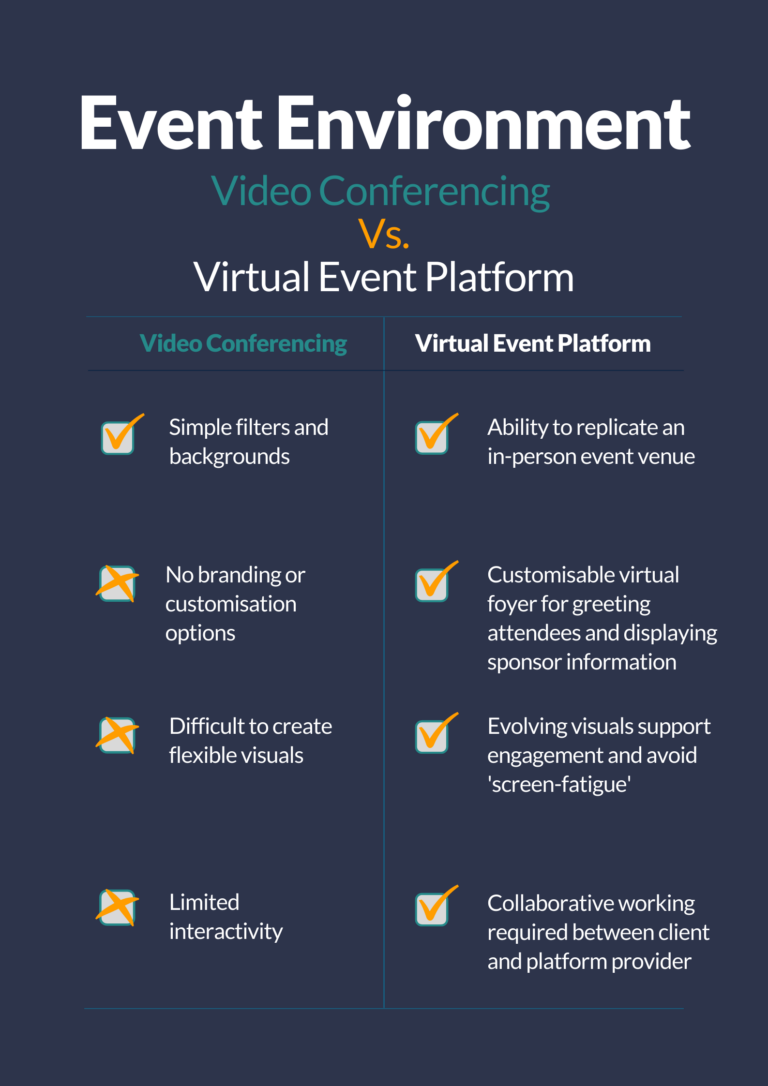There is no doubt that when we all suddenly needed to switch to virtual life in 2019, simple and easy-to-use video conferencing platforms came into their own. Home schooling, business meetings and catching up with family moved into the virtual space, and although times were tough, we were ever grateful for the leaps and bounds in technology that enabled us to feel connected with each other.
As the benefits of offering a virtual and hybrid element to conferences also became clear, many companies decided to use familiar video conferencing platforms, such as Zoom, Microsoft Teams and Google Meet, to host their important events. However, while these platforms are great virtual meeting options, do they have the functionality to deliver a truly engaging virtual event, especially those that are more complicated and involve single-day or multi-day agendas with larger attendee numbers?
No one wants their event to fall short, resulting in disengaged delegates and low retention figures.
We take a look below at both options and highlight the fundamental differences between video conferencing versus built-for-purpose, virtual event platforms:
Registration
Let’s start at the beginning! Registration is often one of the first points of interaction between your event and your attendees (although at CrowdComms, we’d always recommend setting up some pre-event content for your delegates to interact with to encourage early registration). An easy and engaging registration process sets the tone for your whole event and, therefore, is an important one to get right.

The benefits of simple log-in systems synonymous with video conferencing platforms are often short-lived and miss out on valuable branding opportunities and customisation. Not only will a high-quality virtual event platform support a great looking, branded registration page, but it will also have intuitive functionality and data collection that can be used to populate online attendee profiles – saving everyone the hassle of inputting the same information multiple times.
Event Environment
Once attendees have entered the virtual event ‘venue’, what do they see and how does this differ between the two event solutions?
Zoom, for example, has several options to personalise the meeting experience. Attendees can choose from a range of filters or backgrounds, although the backgrounds often require a ‘green screen’ to be effective. With this option for event production, there are no branding or customisation features available to event organisers. It is also difficult in video conferencing platforms to create flexible visuals when delivering content, which can make a long event (from half a day to multi-day events) challenging in terms of sustaining attendees’ engagement.
In contrast to this, the virtual event platform can replicate an in-person event venue and even incorporate an interactive map. There may be a virtual foyer where representatives can greet attendees and direct them to their personalised agenda, customised to show sponsors’ logos alongside event branding. The virtual platform will have a range of visual designs throughout the event, e.g. branded background screens for the keynote speakers and custom surrounds for break-out rooms and speaker sessions.
Mirroring the event experience in this way allows attendees to feel part of the event rather than feeling that they are simply attending a meeting. Evolving visuals support engagement and help avoid ‘screen fatigue’, while interactivity options enable attendees to control their event experience.
At CrowdComms, we work closely with our clients to ensure that their event is customised precisely how they would like it. It takes more time than using a quick-fix option such as a video conferencing platform, but the outstanding feedback from our customers and attendees who have been part of an event powered by CrowdComms, confirms that it is time well spent.

Networking
Networking is one of the key reasons we organise and attend events – to bring people together to exchange and debate ideas, discuss shared interests, do business, make connections and expand their careers. It’s fair to say that recreating the serendipity of in-person event networking has been one of the biggest challenges in delivering virtual events. We had also perhaps overlooked just how important networking is in providing strategic breaks in content-heavy event agendas and, when facilitated well, how much value it offers for the overall attendee experience.
Video conferencing has the functionality to enable attendees to chat before or after the meeting via the video stream. They can also message throughout the event using the chat channel – however, the chat is always open to every attendee. With no option to incorporate personalised information into the experience, attendees can find it challenging to work out who they’d like to connect with. It is also impossible to limit conversations to one or two people; the whole meeting group has to be involved.
The virtual event platform excels at providing the capability for attendees to network in a more meaningful way. Flexible networking technology supports connections across various channels: one-to-one messaging, group chat, private chat channels and, on select platforms, virtual networking rooms where people can connect and interact as they would at an in-person venue. Attendees also can access each other’s profiles to find out who they would like to connect with.

Content Longevity
Your event is packed with engaging content, and you want your attendees to be able to make the most of it for as long as possible. There’s nothing better than watching your delegates enjoy and interact with your sessions – it’s an accurate marker of a successful event.
While video conferencing platforms allow meetings to be recorded and saved to enable distribution at a later date, external filing means that attendees can only access the content if, and when, the meeting holder permits. The recording function also doesn’t automatically edit the content for easy navigation or digestion.
A sophisticated virtual event platform will support content on-demand, and much like streaming services such as Netflix or Binge, attendees can access event content whenever they choose. Easily discoverable, curated content provides a high-quality user experience and enhances the ability for attendees to engage, maximising the potential for longevity of content long after the event has concluded.

Hopefully, this article has given you a good overview of the main differences between using video conferencing platforms and technology that has been built specifically for virtual events. From our experience of running events over the last ten years, we know that time put in at the beginning saves a lot of stress later down the line.




